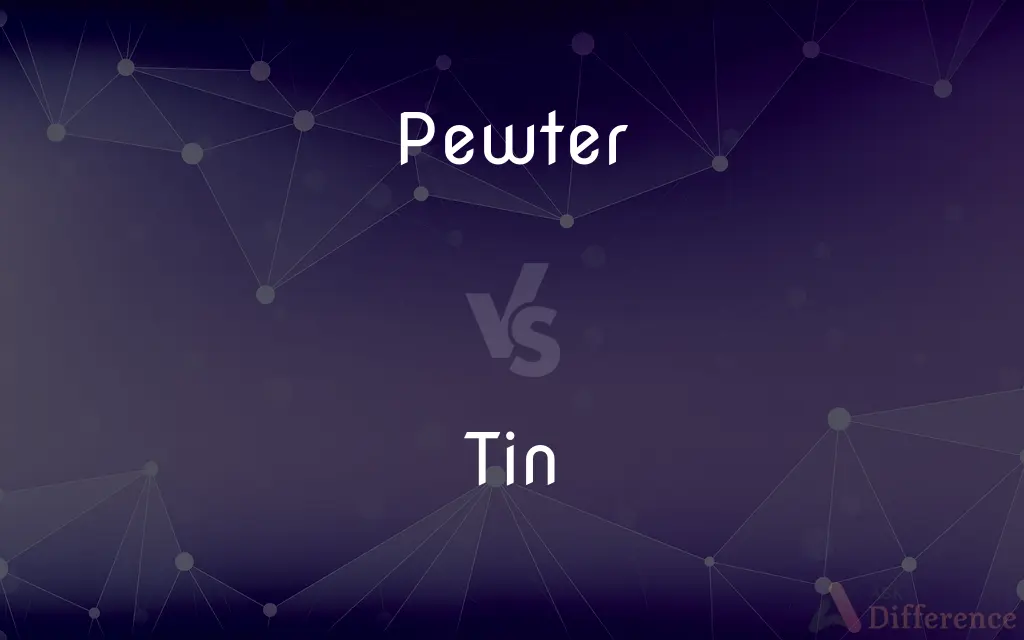Pewter vs. Tin — What's the Difference?
Edited by Tayyaba Rehman — By Urooj Arif — Updated on April 8, 2024
Pewter is a malleable metal alloy primarily made of tin, often used for decorative objects, while tin is a soft, silvery-white metal used in various applications including coatings for steel cans.

Difference Between Pewter and Tin
Table of Contents
ADVERTISEMENT
Key Differences
Pewter, an alloy predominantly composed of tin, often includes antimony and copper to increase its hardness and durability, making it popular for decorative items and tableware. Tin, on the other hand, is a chemical element (Sn) that is soft and malleable, primarily used in the production of solder, pewter, and plating steel to prevent corrosion.
While pewter has been used historically for household items due to its low melting point and ease of casting, tin’s resistance to corrosion and non-toxic nature make it ideal for coating other metals. Pewter objects often carry a hallmark of quality, indicating the tin content, whereas tin's usage is more industrial, critical in making alloys and protective coatings.
Pewter's aesthetic value lies in its warm, silvery sheen that develops a characteristic patina over time, appreciated in art and antiques. In contrast, tin’s appearance is brighter, but it's valued more for its practical applications than its beauty.
The crafting of pewter is an art form, with artisans valuing its workability and finish, while the extraction and processing of tin are more about its utility in manufacturing and industry. Pewter's contribution to cultural heritage through crafted items contrasts with tin's role in technological and industrial advancements.
Comparison Chart
Composition
Alloy primarily of tin, with antimony and copper
Pure chemical element (Sn)
ADVERTISEMENT
Primary Use
Decorative items, tableware
Coating for steel cans, soldering, making alloys
Characteristics
Malleable, low melting point, develops a patina
Soft, malleable, resistant to corrosion
Aesthetic Value
Valued for its sheen and historical significance
Brighter appearance but valued more for practicality
Production Process
Crafted into objects, often with quality hallmarks
Extracted and processed for industrial applications
Compare with Definitions
Pewter
Develops a characteristic patina.
The pewter vase's patina added to its antique charm.
Tin
Non-toxic and resistant to corrosion.
Tin's non-toxicity makes it ideal for food packaging.
Pewter
Used in decorative objects.
The intricate pewter figurine showcased the metal's versatility.
Tin
A chemical element (Sn).
Tin, known chemically as Sn, is a common metal in soldering materials.
Pewter
An alloy of tin.
The pewter mug, made primarily of tin, had a soft, lustrous finish.
Tin
Important for technological applications.
Tin's role in producing electronic components is vital for modern technology.
Pewter
Contains antimony and copper.
Modern pewter blends tin with antimony and copper for durability.
Tin
Used in plating and alloys.
Tin plating protects steel cans from corrosion.
Pewter
Historically significant.
Pewter plates and cups were commonplace in historical households.
Tin
Soft and malleable.
Despite its softness, tin is incredibly useful in industrial applications.
Pewter
Pewter () is a malleable metal alloy consisting of tin (85–99%), antimony (approximately 5–10%), copper (2%), bismuth, and sometimes silver. Copper and antimony (and in antiquity lead) act as hardeners but lead may be used in lower grades of pewter, imparting a bluish tint.
Tin
Tin is a chemical element with the symbol Sn (from Latin: stannum) and atomic number 50. Tin is a silvery metal that characteristically has a faint yellow hue.
Pewter
Any of numerous silver-gray alloys of tin with various amounts of antimony, copper, and sometimes lead, used widely for fine kitchen utensils and tableware.
Tin
Symbol Sn A crystalline, silvery metallic element obtained chiefly from cassiterite, and having two notable allotropic forms. Malleable white tin is the useful allotrope, but at temperatures below 13.2°C it slowly converts to the brittle gray allotrope. Tin is used to coat other metals to prevent corrosion and is a part of numerous alloys, such as soft solder, pewter, type metal, and bronze. Atomic number 50; atomic weight 118.71; melting point 231.93°C; boiling point 2,602°C; specific gravity (gray) 5.77, (white) 7.29; valence 2, 4. See Periodic Table.
Pewter
Pewter articles considered as a group.
Tin
Tin plate.
Pewter
An alloy of approximately 93–98% tin, 1–2% copper, and the balance of antimony.
Tin
A container or box made of tin plate.
Pewter
(historical) An alloy of tin and lead.
Tin
A container for preserved foodstuffs; a can.
Pewter
Items made of pewter; pewterware.
Tin
The contents of such a container.
Pewter
A beer tankard made from pewter.
Tin
To plate or coat with tin.
Pewter
A dark, dull grey colour, like that of the metal.
Tin
Chiefly British To preserve or pack in tins; can.
Pewter
Prize money.
Tin
Of, relating to, or made of tin.
Pewter
Of a dark, dull grey colour, like that of the metal.
Tin
Constructed of inferior material.
Pewter
(transitive) To coat with pewter.
Tin
Spurious.
Pewter
A hard, tough, but easily fusible, alloy, originally consisting of tin with a little lead, but afterwards modified by the addition of copper, antimony, or bismuth.
Tin
(uncountable) A malleable, ductile, metallic element, resistant to corrosion, with atomic number 50 and symbol Sn.
Pewter
Utensils or vessels made of pewter, as dishes, porringers, drinking vessels, tankards, pots.
Tin
An airtight container, made of tin or another metal, used to preserve food, or hold a liquid or some other product.
A tin of baked beans; a tobacco tin; a tin of shoe polish
Empty tins, cans, and plastic containers are recycled in the blue bins.
Pewter
Any of various alloys of tin with small amounts of other metals (especially lead)
Tin
(countable) A metal pan used for baking, roasting, etc.
Muffin tin
Roasting tin
Baking tin
Tin
The bottom part of the front wall, which is "out" if a player strikes it with the ball.
Tin
Money, especially silver money.
Tin
Computer hardware.
Tin
Made of tin.
Tin
Made of galvanised iron or built of corrugated iron.
Tin
(transitive) To place into a metal can (ie. a tin; be it tin, steel, aluminum) in order to preserve.
Tin
(transitive) To cover with tin.
Tin
(transitive) To coat with solder
Tin
To coat with solder, in preparation for soldering, to ensure a good solder joint
Tin
To coat with solder, in order to consolidate braided wire, so as to make contact with all strands and reduce fragility of the fraying wire
Tin
An elementary substance found as an oxide in the mineral cassiterite, and reduced as a soft silvery-white crystalline metal, with a tinge of yellowish-blue, and a high luster. It is malleable at ordinary temperatures, but brittle when heated. It is softer than gold and can be beaten out into very thin strips called tinfoil. It is ductile at 2120, when it can be drawn out into wire which is not very tenacious; it melts at 4420, and at a higher temperature burns with a brilliant white light. Air and moisture act on tin very slightly. The peculiar properties of tin, especially its malleability, its brilliancy and the slowness with which it rusts make it very serviceable. With other metals it forms valuable alloys, as bronze, gun metal, bell metal, pewter and solder. It is not easily oxidized in the air, and is used chiefly to coat iron to protect it from rusting, in the form of tin foil with mercury to form the reflective surface of mirrors, and in solder, bronze, speculum metal, and other alloys. Its compounds are designated as stannous, or stannic. Symbol Sn (Stannum). Atomic weight 117.4.
Tin
Thin plates of iron covered with tin; tin plate.
Tin
Money.
Tin
To cover with tin or tinned iron, or to overlay with tin foil.
Tin
A silvery malleable metallic element that resists corrosion; used in many alloys and to coat other metals to prevent corrosion; obtained chiefly from cassiterite where it occurs as tin oxide
Tin
Metal container for storing dry foods such as tea or flour
Tin
Airtight sealed metal container for food or drink or paint etc.
Tin
Plate with tin
Tin
Preserve in a can or tin;
Tinned foods are not very tasty
Tin
Prepare (a metal) for soldering or brazing by applying a thin layer of solder to the surface
Common Curiosities
What is pewter made of?
Pewter is an alloy made primarily of tin, often combined with antimony and copper.
How can you tell if something is made of pewter?
Pewter items often have a hallmark or stamp indicating their composition.
How is tin used in everyday products?
Tin is commonly used to coat steel cans for food preservation and in solder for electronics.
What are the environmental impacts of mining tin?
Tin mining can lead to soil erosion, water pollution, and biodiversity loss if not managed responsibly.
How is pewter crafted?
Pewter is melted and cast into molds to create various decorative and functional items.
Can pewter be used for food containers?
Yes, modern pewter, which is lead-free, is safe for food containers and tableware.
Why is tin important in the industry?
Tin is crucial for its use in corrosion-resistant plating and as a component in various alloys.
Are there health concerns associated with pewter?
Modern pewter is lead-free and considered safe, but antique pewter may contain lead.
What does a patina on pewter indicate?
A patina on pewter indicates age and exposure to air, often considered desirable for its aesthetic.
Why is pewter popular in antiques?
Pewter's historical use and unique finish make it popular among antique collectors.
Is pewter more expensive than tin?
Pewter, being an alloy crafted into decorative items, can be more expensive than raw tin.
Can tin be recycled?
Yes, tin is highly recyclable, with many industrial processes reclaiming and reusing it.
What makes tin so versatile?
Tin's malleability and corrosion resistance make it versatile for industrial and manufacturing uses.
How has the use of pewter changed over time?
Once used for common household items, pewter is now more often valued for its artistic and decorative qualities.
How does tin protect against corrosion?
Tin protects steel by acting as a barrier to air and water, preventing rust.
Share Your Discovery

Previous Comparison
Handle vs. Control
Next Comparison
Zillion vs. TrillionAuthor Spotlight
Written by
Urooj ArifUrooj is a skilled content writer at Ask Difference, known for her exceptional ability to simplify complex topics into engaging and informative content. With a passion for research and a flair for clear, concise writing, she consistently delivers articles that resonate with our diverse audience.
Edited by
Tayyaba RehmanTayyaba Rehman is a distinguished writer, currently serving as a primary contributor to askdifference.com. As a researcher in semantics and etymology, Tayyaba's passion for the complexity of languages and their distinctions has found a perfect home on the platform. Tayyaba delves into the intricacies of language, distinguishing between commonly confused words and phrases, thereby providing clarity for readers worldwide.















































